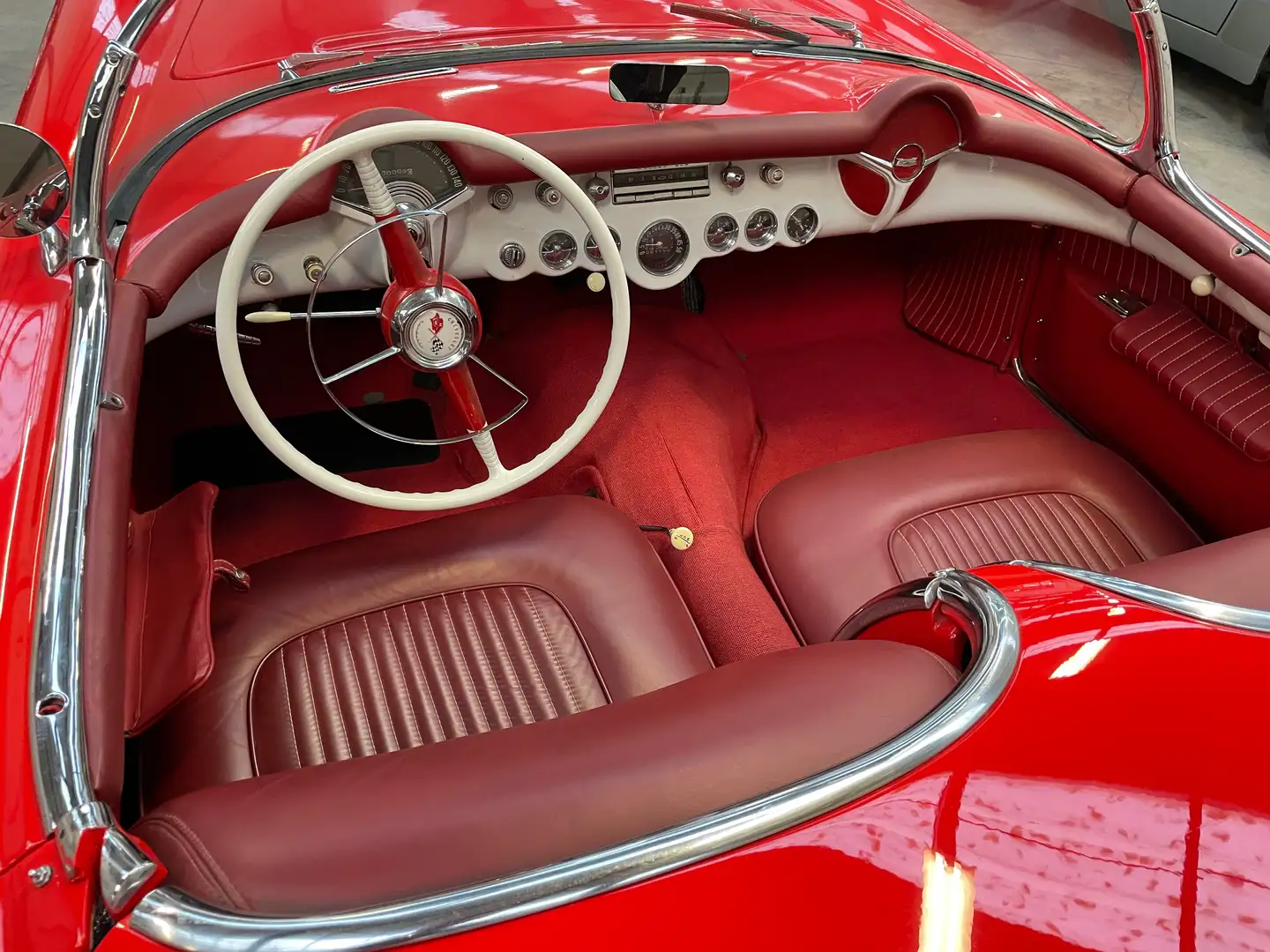detailpage.leasing.tip.text
Corvette C1BLUE FLAME FULL RESTORED OLDTIMER 0483/47.20.60
€ 85 000,-
Do negocjacji
Auto Mobile Invest
Przebieg
9 km
Rodzaj skrzyni biegów
Automatyczna
Pierwsza rejestracja
01/1954
Paliwo
Benzyna
Moc
110 kW (150 KM)
Sprzedający
Dealer
Dane podstawowe
- Rodzaj nadwozia
- Kabriolet
- Typ
- Oldtimer
- Rodzaj napędu
- Na tylnie koła
- Liczba miejsc siedzących
- 2
- Liczba drzwi
- 2
- Wersja krajowa
- Belgia
Historia pojazdu
- Przebieg
- 9 km
- Pierwsza rejestracja
- 01/1954
- Ostatni serwis techniczny
- 11/2022
- Właśc. samochodu
- 2
- Pojazd osoby niepalącej
- Tak
Dane Techniczne
- Moc
- 110 kW (150 KM)
- Rodzaj skrzyni biegów
- Automatyczna
- Pojemność
- 3 859 cm³
- Biegi
- 4
- Cylinder
- 6
Zużycie energii
- Paliwo
- Super Plus 98
Wyposażenie
- Komfort i wygoda
- Skórzana tapicerka
Kolor i Tapicerka
- Kolor lakieru
- Czerwony
- Kolor wyposażenia wewnętrznego
- Czerwony
- Materiał
- skóra
Opis pojazdu
The Corvette legend was powered by V-8 engines, but it was an inline six-cylinder that started it all. Chevrolet’s 235-cu.in. six was the only engine available in the Corvette for 1953 and ’54. In ’55, the 265 V-8 was offered as an option and most of the 700 Corvettes built were small-block powered, leading to the inline engine’s demise in ’56. More than 60 years (and counting) since, every Corvette has had a V-8 under its hood, despite persistent rumors for decades that a V-6 could be on the horizon. The Blue Flame Six wasn’t the most fiery engine to ever power Chevrolet’s long-lived sports car, but it was made hotter than its passenger car counterparts thanks to hop-ups and custom touches applied by the engineering team that developed the first Corvette1. A special rocker cover for the ’53 Corvette six had rounded ends, recesses for the hold-down nuts, and the oil filler was moved rearward. This is a rare piece of Chevrolet engine tin today.
2. A mechanical camshaft with .405/.414 lift, a compression bump from 7.5:1 to 8:1, and dual exhausts exiting out of a two-outlet manifold helped raise output from 115 to 150 hp.
3. To keep the engine’s profile low, a trio of Carter YH-2066-S side-draft single-barrel carburetors were mounted to an aluminum intake. Fuel was fed by a mechanical double-action pump.
4. The Corvette engine was based on the six that was paired with Powerglides in passenger cars, so it had full-pressure lubrication and aluminum pistons. The passenger-car engine used a hydraulic camshaft, however, and a fiber timing gear. The ’Vette engine had solid tappets and an aluminum gear.
5. Due to a lack of shielding from the fiberglass body, radio interference from the ignition was a problem, so the Corvette engine had this stamped shield that covered the distributor, coil, and wires.
6. The radiator was low profile, so the expansion tank was mounted alongside the rocker cover. The Corvette water pump and impeller were special, too, designed for high output in a compact size.
SPECIFICATIONS
1953 Chevrolet Corvette Blue Flame Six
Type: Inline-six; cast-iron block and head
Displacement: 235.5-cu.in.
Bore and stroke: 3-9/16 X 3-15/16 inches
Compression: 8:1
Horsepower: 150 @ 4,200 rpm
Torque: 223 lb-ft@2,400 rpm
Pistons: Cast aluminum with steel struts
Connecting rods: Drop-forged steel
Camshaft: Mechanical with aluminum timing gear
Carburetion: Three side-draft one-barrels
Auto Mobile Invest is niet verantwoordelijk voor eventuele fouten in deze advertentie
2. A mechanical camshaft with .405/.414 lift, a compression bump from 7.5:1 to 8:1, and dual exhausts exiting out of a two-outlet manifold helped raise output from 115 to 150 hp.
3. To keep the engine’s profile low, a trio of Carter YH-2066-S side-draft single-barrel carburetors were mounted to an aluminum intake. Fuel was fed by a mechanical double-action pump.
4. The Corvette engine was based on the six that was paired with Powerglides in passenger cars, so it had full-pressure lubrication and aluminum pistons. The passenger-car engine used a hydraulic camshaft, however, and a fiber timing gear. The ’Vette engine had solid tappets and an aluminum gear.
5. Due to a lack of shielding from the fiberglass body, radio interference from the ignition was a problem, so the Corvette engine had this stamped shield that covered the distributor, coil, and wires.
6. The radiator was low profile, so the expansion tank was mounted alongside the rocker cover. The Corvette water pump and impeller were special, too, designed for high output in a compact size.
SPECIFICATIONS
1953 Chevrolet Corvette Blue Flame Six
Type: Inline-six; cast-iron block and head
Displacement: 235.5-cu.in.
Bore and stroke: 3-9/16 X 3-15/16 inches
Compression: 8:1
Horsepower: 150 @ 4,200 rpm
Torque: 223 lb-ft@2,400 rpm
Pistons: Cast aluminum with steel struts
Connecting rods: Drop-forged steel
Camshaft: Mechanical with aluminum timing gear
Carburetion: Three side-draft one-barrels
Auto Mobile Invest is niet verantwoordelijk voor eventuele fouten in deze advertentie
Leasing
detailpage.leasing.title Auto Mobile Invest
detailpage.leasing.oneTimeCosts
- detailpage.leasing.configurator.downPayment
- € 0,-
- shared.listItem.leasing.transferCost
- Keine Angabe
- shared.listItem.leasing.registrationCost
- Keine Angabe
- detailpage.leasing.total
- € 0,-
detailpage.leasing.generalData
- detailpage.leasing.contractType
- Kilometerleasing
- detailpage.leasing.mileage p.a.
- 10.000 km
detailpage.leasing.monthlyCosts
- detailpage.leasing.duration
- 48 Monate
- detailpage.leasing.monthlyInstallment
- € 446,22
detailpage.leasing.additionalInformation
- detailpage.leasing.finalInstallment
- € 28.520,71
detailpage.leasing.tip.headline
detailpage.leasing.loanBrokerage Volkswagen Leasing GmbH / Gifhorner Str. 57 / 38112 Braunschweig
Die Angaben entsprechen zugleich dem 2/3 Beispiel nach § 6a Abs. 3 PAngV.
Sprzedający
DealerAuto Mobile Invest
Dealer na AutoScout24 od 2022
KontaktJim Duyck
- Możliwość odliczenia VAT-u
- Cena dla sprzedawcy

